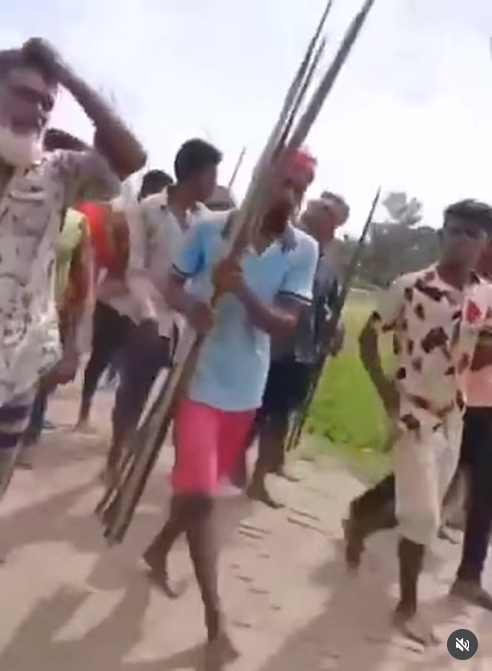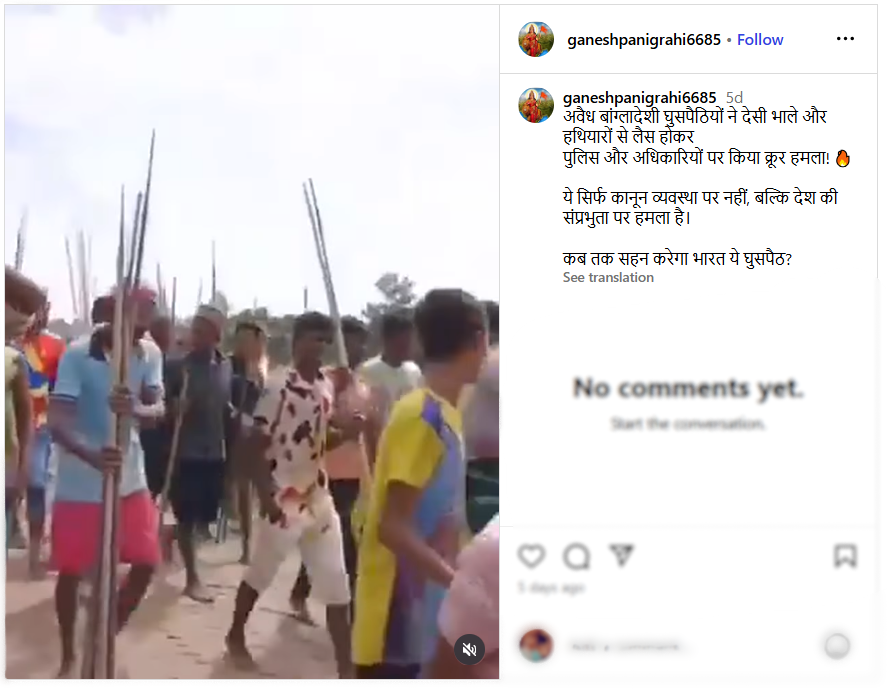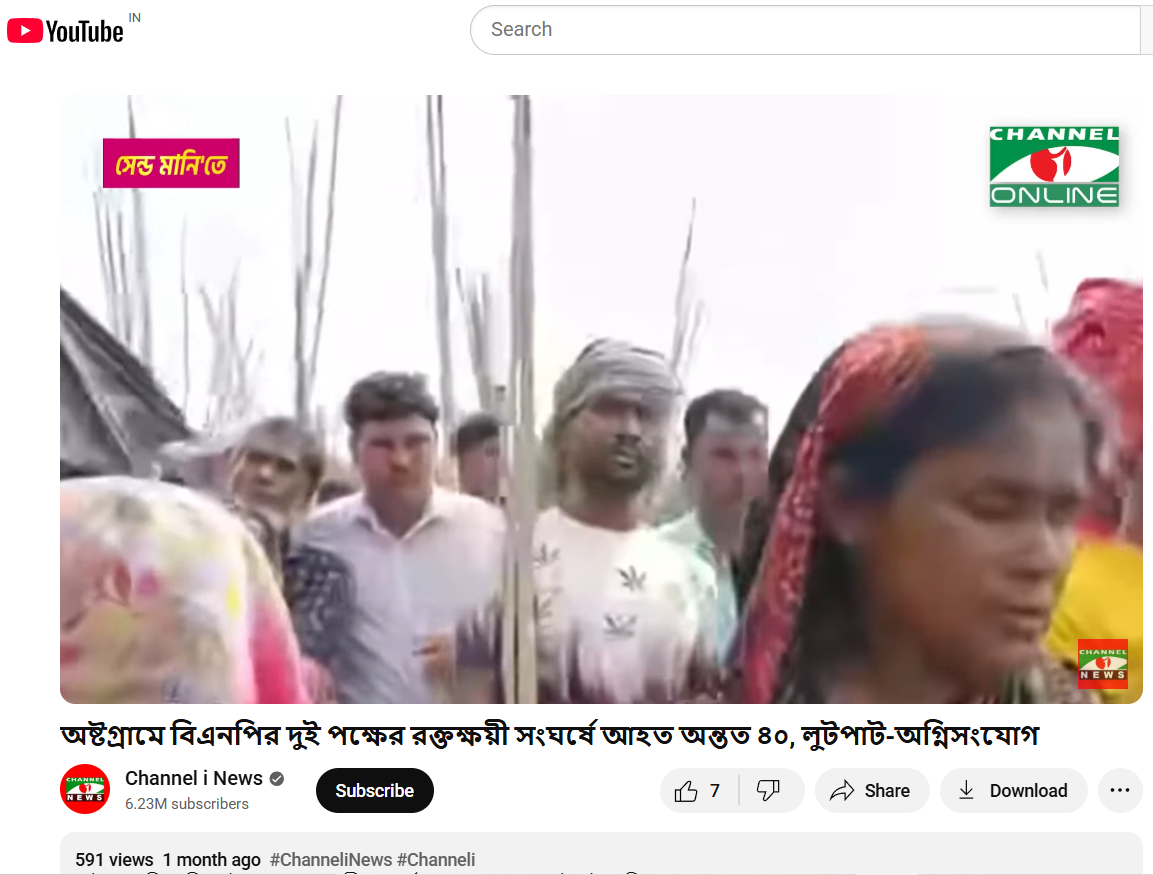#Fact Check: Viral Footage from Bangladesh Incorrectly Portrayed as Immigrant March for Violence in Assam.
Executive Summary:
As we researched a viral social media video we encountered, we did a comprehensive fact check utilizing reverse image search. The video circulated with the claim that it shows illegal Bangladeshi in Assam's Goalpara district carrying homemade spears and attacking a police and/or government official. Our findings are certain that this claim is false. This video was filmed in the Kishoreganj district, Bangladesh, on July 1, 2025, during a political argument involving two rival factions of the Bangladesh Nationalist Party (BNP). The footage has been intentionally misrepresented, putting the report into context regarding Assam to disseminate false information.

Claim:
The viral video shows illegal Bangladeshi immigrants armed with spears marching in Goalpara, Assam, with the intention of attacking police or officials.

Fact Check:
To establish if the claim was valid, we performed a reverse image search on some of the key frames from the video. We did our research on a number of news articles and social media posts from Bangladeshi sources. This led us to a reality check as the events confirmed in these reports took place in Ashtagram, Kishoreganj district, Bangladesh, in a violent political confrontation between factions of the Bangladesh Nationalist Party (BNP) on July 1, 2025, that ultimately resulted in about 40 injuries.

We also found on local media, in particular, Channel i News reported full accounts of the viral report and showed images from the video post. The individuals seen in the video were engaged in a political fight and wielding makeshift spears rather than transitioning into a cross-border attack. The Assam Police issued an official response on X (formerly Twitter) that denied the claim, while noting that nothing of that nature occurred in Goalpara nor in any other district of Assam.


Conclusion:
Based on our research, we conclude that the viral video does not show unlawful Bangladeshi immigrants in Assam. It depicts a political clash in Kishoreganj, Bangladesh, on July 1, 2025. The claim attached to the video is completely untrue and is intended to mislead the public as to where and what the incident depicted is.
Claim: Video shows illegal migrants with spears moving in groups to assault police!
Claimed On: Social Media
Fact Check: False and Misleading
Related Blogs

Introduction:
The Ministry of Civil Aviation, GOI, established the initiative ‘DigiYatra’ to ensure hassle-free and health-risk-free journeys for travellers/passengers. The initiative uses a single token of face biometrics to digitally validate identity, travel, and health along with any other data needed to enable air travel.
Cybersecurity is a top priority for the DigiYatra platform administrators, with measures implemented to mitigate risks of data loss, theft, or leakage. With over 6.5 million users, DigiYatra is an important step forward for India, in the direction of secure digital travel with seamless integration of proactive cybersecurity protocols. This blog focuses on examining the development, challenges and implications that stand in the way of securing digital travel.
What is DigiYatra? A Quick Overview
DigiYatra is a flagship initiative by the Government of India to enable paperless travel, reducing identity checks for a seamless airport experience. This technology allows the entry of passengers to be automatically processed based on a facial recognition system at all the checkpoints at the airports, including main entry, security check areas, aircraft boarding, and more.
This technology makes the boarding process quick and seamless as each passenger needs less than three seconds to pass through every touchpoint. Passengers’ faces essentially serve as their documents (ID proof and if required, Vaccine Proof) and their boarding passes.
DigiYatra has also enhanced airport security as passenger data is validated by the Airlines Departure Control System. It allows only the designated passengers to enter the terminal. Additionally, the entire DigiYatra Process is non-intrusive and automatic. In improving long-standing security and operational airport protocols, the platform has also significantly improved efficiency and output for all airport professionals, from CISF personnel to airline staff members.
Policy Origins and Framework
Rooted in the Government of India's Digital India campaign and enabled by the National Civil Aviation Policy (NCAP) 2016, DigiYatra aims to modernise air travel by integrating Aadhaar-based passenger identification. While Aadhaar is currently the primary ID, efforts are underway to include other identification methods. The platform, supported by stakeholders like the Airports Authority of India (26%) and private airports (14.8% each), must navigate stringent cybersecurity demands. Compliance with the Digital Personal Data Protection Act, 2023, ensures the secure use of sensitive facial recognition data, while the Aircraft (Security) Rules, 2023, mandate robust interoperability and data protection mechanisms across stakeholders. DigiYatra also aspires to democratise digital travel, extending its reach to underserved airports and non-tech-savvy travellers. As India refines its cybersecurity and privacy frameworks, learning from global best practices is essential to safeguarding data and ensuring seamless, secure air travel operations.
International Practices
Global practices offer crucial lessons to strengthen DigiYatra's cybersecurity and streamline the seamless travel experience. Initiatives such as CLEAR in the USA and Seamless Traveller initiatives in Singapore offer actionable insights into further expanding the system to its full potential. CLEAR is operational in 58 airports and has more than 17 million users. Singapore has made Seamless Traveller active since the beginning of 2024 and aims to have a 95% shift to automated lanes by 2026.
Some additional measures that India can adopt from international initiatives are regular audits and updates to the cybersecurity policies. Further, India can aim for a cross-border policy for international travel. By implementing these recommendations, DigiYatra can not only improve data security and operational efficiency but also establish India as a leader in global aviation security standards, ensuring trust and reliability for millions of travellers
CyberPeace Recommendations
Some recommendations for further improving upon our efforts for seamless and secure digital travel are:
- Strengthen the legislation on biometric data usage and storage.
- Collaborate with global aviation bodies to develop standardised operations.
- Cybersecurity technologies, such as blockchain for immutable data records, should be adopted alongside encryption standards, data minimisation practices, and anonymisation techniques.
- A cybersecurity-first culture across aviation stakeholders.
Conclusion
DigiYatra represents a transformative step in modernising India’s aviation sector by combining seamless travel with robust cybersecurity. Leveraging facial recognition and secure data validation enhances efficiency while complying with the Digital Personal Data Protection Act, 2023, and Aircraft (Security) Rules, 2023.
DigiYatra must address challenges like secure biometric data storage, adopt advanced technologies like blockchain, and foster a cybersecurity-first culture to reach its full potential. Expanding to underserved regions and aligning with global best practices will further solidify its impact. With continuous innovation and vigilance, DigiYatra can position India as a global leader in secure, digital travel.
References
- https://government.economictimes.indiatimes.com/news/governance/digi-yatra-operates-on-principle-of-privacy-by-design-brings-convenience-security-ceo-digi-yatra-foundation/114926799
- https://www.livemint.com/news/india/explained-what-is-digiyatra-how-it-will-work-and-other-questions-answered-11660701094885.html
- https://www.civilaviation.gov.in/sites/default/files/2023-09/ASR%20Notification_published%20in%20Gazette.pdf
%20(2).webp)
Introduction
Digitalization in India has been a transformative force, India is also marked as the second country in the world in terms of active internet users. With this adoption of digitalization and technology, the country is becoming a digitally empowered society and knowledge-based economy. However, the number of cyber crimes in the country has also seen a massive spike recently with the sophisticated cyber attacks and manipulative techniques being used by cybercriminals to lure innocent individuals and businesses.
As per recent reports, over 740,000 cybercrime cases were reported to the I4C, in the first four months of 2024, which raises serious concern on the growing nature of cyber crimes in the country. Recently Prime Minister Modi in his Mann Ki Baat address, cautioned the public about a particular rising cyber scam known as ‘digital arrest’ and highlighted the seriousness of the issue and urged people to be aware and alert about such scams to counter them. The government has been keen on making efforts to reduce and combat cyber crimes by introducing new measures and strengthening the regulatory landscape governing cyberspace in India.
Indian Cyber Crime Coordination Centre
Indian Cybercrime Coordination Centre (I4C) was established by the Ministry of Home Affairs (MHA) to provide a framework and eco-system for law enforcement agencies (LEAs) to deal with cybercrime in a coordinated and comprehensive manner. I4C handles the ‘National Cyber Crime Reporting Portal’ (https://cybercrime.gov.in) and the 1930 Cyber Crime Helpline. Recently at the Indian Cyber Crime Coordination Centre (I4C) Foundation Day celebration, Union Home Minister Amit Shah launched the Cyber Fraud Mitigation Centre (CFMC), Samanvay platform (Joint Cybercrime Investigation Facilitation System), 'Cyber Commandos' program and Online Suspect Registry as efforts to combat the cyber crimes, establish cyber resilence and awareness and strengthening capabilities of law enforcement agencies.
Regulatory landscape Governing Cyber Crimes
Information Technology Act, 2000 (IT Act) and the rules made therein, the Intermediary Guidelines, Digital Personal Data Protection Act, 2023 and Bhartiya Nyay Sanhita, 2023 are the major legislation in India governing Cyber Laws.
CyberPeace Recommendations
There has been an alarming uptick in cybercrimes in the country highlighting the need for proactive approaches to counter these emerging threats. The government should prioritise its efforts by introducing robust policies and technical measures to reduce cybercrime in the country. The law enforcement agencies' capabilities must be strengthened with advanced technologies to deal with cyber crimes especially considering the growing sophisticated nature of cyber crime tactics used by cyber criminals.
The netizens must be aware of the manipulative tactics used by cyber criminals to target them. Social media companies must also implement robust measures on their respective platforms to counter and prevent cyber crimes. Coordinated approaches by all relevant authorities, including law enforcement, cybersecurity agencies, and regulatory bodies, along with increased awareness and proactive engagement by netizens, can significantly reduce cyber threats and online criminal activities.
References
- https://www.statista.com/statistics/1499739/india-cyber-crime-cases-reported-to-i4c/#:~:text=Cyber%20crime%20cases%20registered%20by%20I4C%20India%202019%2D2024&text=Over%20740%2C000%20cases%20of%20cyber,related%20to%20online%20financial%20fraud
- https://www.deccanherald.com/india/parliament-panel-to-examine-probe-agencies-efforts-to-tackle-cyber-crime-illegal-immigration-3270314
- https://pib.gov.in/PressReleaseIframePage.aspx?PRID=2003158

Introduction
Since the inception of the Internet and social media platforms like Facebook, X (Twitter), Instagram, etc., the government and various other stakeholders in both foreign jurisdictions and India have looked towards the intermediaries to assume responsibility for the content floated on these platforms, and various legal provisions showcase that responsibility. For the first time in many years, these intermediaries come together to moderate the content by setting a standard for the creators and propagators of this content. The influencer marketing industry in India is at a crucial juncture, with its market value projected to exceed Rs. 3,375 crore by 2026. But every industry is coupled with its complications; like in this scenario, there is a section of content creators who fail to maintain the standard of integrity and propagate content that raises concerns of authenticity and transparency, often violating intellectual property rights (IPR) and privacy.
As influencer marketing continues to shape digital consumption, the need for ethical and transparent content grows stronger. To address this, the India Influencer Governing Council (IIGC) has released its Code of Standards, aiming to bring accountability and structure to the fast-evolving online space.
Bringing Accountability to the Digital Fame Game
The India Influencer Governing Council (IIGC), established on 15th February, 2025, is founded with the objective to empower creators, advocate for fair policies, and promote responsible content creation. The IIGC releases the Code of Standard, not a moment too soon; it arrives just in time, a necessary safeguard before social media devolves into a chaotic marketplace where anything and everything is up for grabs. Without effective regulation, digital platforms become the marketplace for misinformation and exploitation.
The IIGC leads the movement with clarity, stating that the Code is a significant piece that spans across 20 crucial sections governing key areas such as paid partnership disclosures, AI-generated personas, content safety, and financial compliance.
Highlights from the Code of Standard
- The Code exhibits a technical understanding of the industry of content creation and influencer marketing. The preliminary sections advocate for accuracy, transparency, and maintaining credibility with the audience that engages with the content. Secondly, the most fundamental development is with regard to the “Paid Partnership Disclosure” included in Section 2 of the Code that mandates disclosure of any material connection, such as financial agreements or collaboration with the brand.
- Another development, which potently comes at a befitting hour, is the disclosure of “AI Influencers”, which establishes that the nature of the influencer has to be disclosed, and such influencers, whether fully virtual or partially AI-enhanced, must maintain the same standards as any human influencer.
- The code ranges across various other aspects of influencer marketing, such as expressing unpaid “Admiration” for the brand and public criticism of the brand, being free from personal bias, honouring financial agreements, non-discrimination, and various other standards that set the stage for a safe and fair digital sphere.
- The Code also necessitates that the platform users and the influencers handle sexual and sensitive content with sincere deliberation, and usage of such content shall be for educational and health-related contexts and must not be used against community standards. The Code includes various other standards that work towards making digital platforms safer for younger generations and impressionable minds.
A Code Without Claws? Challenges in Enforcement
The biggest obstacle to the effective implementation of the code is distinguishing between an honest promotion and a paid brand collaboration without any explicit mention of such an agreement. This makes influencer marketing susceptible to manipulation, and the manipulation cannot be tackled with a straitjacket formula, as it might be found in the form of exaggerated claims or omission of critical information.
Another hurdle is the voluntary compliance of the influencers with the advertising standards. Influencer marketing is an exercise in a borderless digital cyberspace, where the influencers often disregard the dignified standards to maximise their earnings and commercial motives.
The debate between self-regulation and government oversight is constantly churning, where experience tells us that overreliance on self-regulation has proven to be inadequate, and succinct regulatory oversight is imperative in light of social media platforms operating as a transnational commercial marketplace.
CyberPeace Recommendations
- Introduction of a licensing framework for influencers that fall into the “highly followed” category with high engagement, who are more likely to shape the audience’s views.
- Usage of technology to align ethical standards with influencer marketing practices, ensuring that misleading advertisements do not find a platform to deceive innocent individuals.
- Educating the audience or consumers on the internet about the ramifications of negligence and their rights in the digital marketplace. Ensuring a well-established grievance redressal mechanism via digital regulatory bodies.
- Continuous and consistent collaboration and cooperation between influencers, brands, regulators, and consumers to establish an understanding and foster transparency and a unified objective to curb deceptive advertising practices.
References
- https://iigc.org/code-of-standards/influencers/code-of-standards-v1-april.pdf
- https://legalonus.com/the-impact-of-influencer-marketing-on-consumer-rights-and-false-advertising/
- https://exhibit.social/news/india-influencer-governing-council-iigc-launched-to-shape-the-future-of-influencer-marketing/


